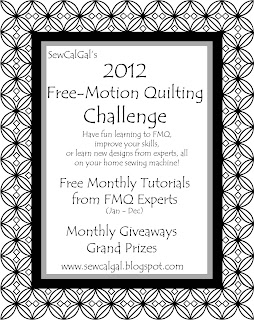Many FMQ questions will be addressed in various tutorials, on one of the FMQ Experts' Blog, or on the Facebook page for this group (2012 Free Motion Quilting Challenge). I will also use this page to log many of the questions and answers on this page. This page will also be updated periodically, so you may want to refer back to this page periodically to see if a question has already been asked, or if there is an answer to one of your questions.
Also, the default assumption is answers are mine, unless noted otherwise. If I find a link to a good reference, I will add that link. If I receive feedback from an FMQ Expert, I'll clarify which Expert shared their insight.
How do I join this challenge?
- Read the page labeled "Free Motion Quilting Challenge", take The Pledge, and sign up for the email list for this group.
- It is never too late. While tutorials will be released monthly, you can do these exercises anytime, and follow along at your leisure. It is more of a matter that if you complete a tutorial exercise in the month that it is released, you can enter to win a monthly prize. If you complete all 12 of the FMQ Challenge tutorials anytime in 2012 you can enter to win a Grand Prize.
- This challenge is focused on those with a home (domestic) sewing machine. The thought of having a different change for those with midarm and/or longarm machines is under consideration. Insights may still be of interest to those using midarm/longarm sewing machines, and FMQ designs may also be of interest, but the actual challenge is focused on home sewing machines.
I know how to do FMQ, but what do you do with the quilting?
- This may be covered in one or more of the FMQ tutorials, or on an FMQ Experts blog. SewCalGal recommends building a library of FMQ quilting books and FMQ DVDs, as well as taking classes where there is frequently a sharing of quilts and group discussion on how various quilts should be quilted.
- You'll find a variety of preferences for various FMQ techniques. SewCalGal recommends you try both, follow the advice of the FMQ Experts, but my personal preference is to drop my feeddogs.
How do you work with so much fabric in a domestic machine?
- Start building your skills with a practice quilt sandwich and work on small quilt sizes first. Overtime, try working on large projects. There are a variety of ways to work on large projects, but you need to assess your work area for how your quilt will move around. You do not want it to hang off the table, as the weight will make it difficult to move around on your sewing bed. SewCalGal recommends you take classes with FMQ Teachers that work on large projects, to see how quilts are physically placed and moved while being quilted on a domestic machine.
How come I can't get my bobbin thread to come up before I start sewing ?
- Hold the end of your top thread and slowly run your machine to do a single stitch, where your top thread will pull up your bobbin thread. Troubleshooting may be that you need to pull out your bobbin thread to verify it was wound thru the bobbin case properly, as well as it has long enough thread for the top thread to pull it up. Verify your machine is clean, free of lint. You may also need to take your machine in for service.
- Two common reasons are moving the quilt sandwich too fast around curves and having tension issues. There are also many wonderful FMQ quilting books that share excellent troubleshooting tips for this type of issue.
How to start/stop and hide your threads ?
What machines are the FMQ Experts using?
Many of the FMQ Experts use a variety of machines, but their primary machine is:
- Sarah Vedeler (Bernina 830)
- Frances Moore (Juki)
- Paula Reid (Bernina 730)
- Diane Gaudynski (Bernina 730)



the Pajamaquilter www.pajamaquilter.com is having a sale right now, just in time for the quilt along! I love her dvd's and books and am not afiliated with her, but throught I'd pass this along to anyone who needs some help.
ReplyDeleteI have a 2' x 3' whiteboards as recommended by Pajamaquilter and it is really easy to use together the motion in your brain. You can just wipe it clean and is cheaper than using fabric for initial practices,
ReplyDeleteI have chosen to do the square sample which I have made up and made my sandwich. After quilting in the ditch, would it be in order to bind the quilt. I feel that having my sampler around for a whole year, the edges are going to fray terribly. The other alternative is to bring the backing fabric around to the front and tack it, enclosing the batting. Thinking about it, the latter might be the better solution?
ReplyDelete